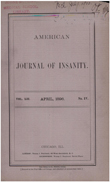Dissociation: the clinical realities
Abstract
An attempt was made by the authors of DSM-III to restrict its focus to the experimental, the observable, and the measurable. The intention was to free the nosology from the influence of unproven theories, and the philosophy was driven largely by the importance of research being able to identify diagnostic categories to facilitate the study of homogeneous groups. So it is of interest that the authors accepted dissociation-an ambiguous event linked to an explicit theoretical concept that had been introduced by Janet-as the basis for classification of clinical presentations that were formerly included under the rubric of hysteria, a similarly unclear category. Since DSM- III, there have been an increasing number of reports of dissociative experiences and dissociative identity disorder (formerly known as multiple personality disorder), but neither of these clinical presentations seems able to withstand the concern that it is dramatically influenced by environmental cues, e.g., the expectations of the therapist. Thus, a restricted phenomenological perspective does not fully appreciate the distorting potential of suggestibility and imagination on the nature of the emerging clinical picture. These factors might well have contributed to and laid the conceptual groundwork for the growth in the number of reports of dissociation.
Access content
To read the fulltext, please use one of the options below to sign in or purchase access.- Personal login
- Institutional Login
- Sign in via OpenAthens
- Register for access
-
Please login/register if you wish to pair your device and check access availability.
Not a subscriber?
PsychiatryOnline subscription options offer access to the DSM-5 library, books, journals, CME, and patient resources. This all-in-one virtual library provides psychiatrists and mental health professionals with key resources for diagnosis, treatment, research, and professional development.
Need more help? PsychiatryOnline Customer Service may be reached by emailing [email protected] or by calling 800-368-5777 (in the U.S.) or 703-907-7322 (outside the U.S.).



